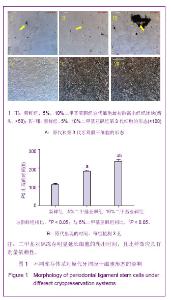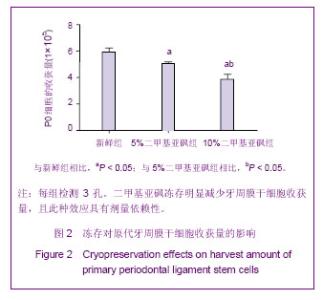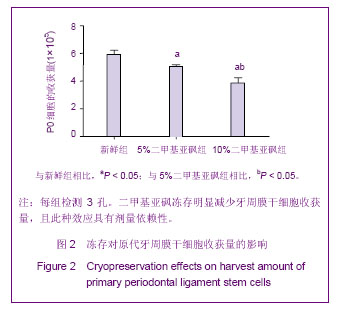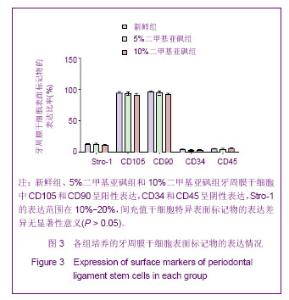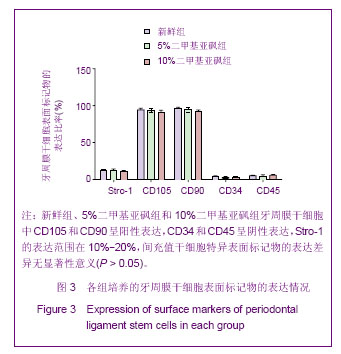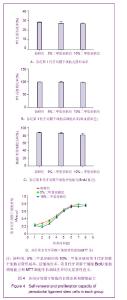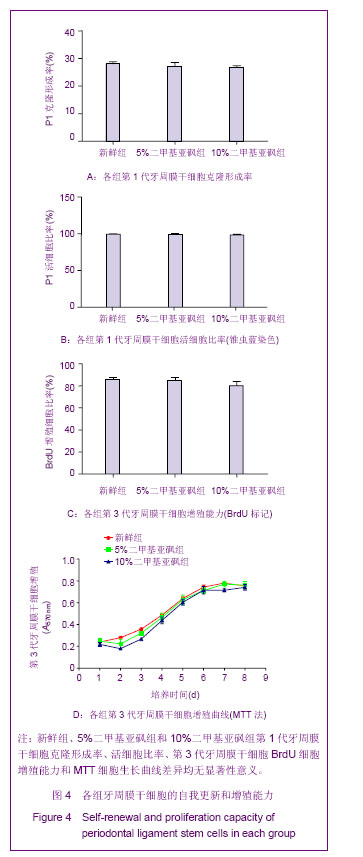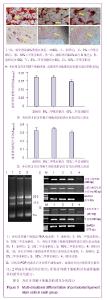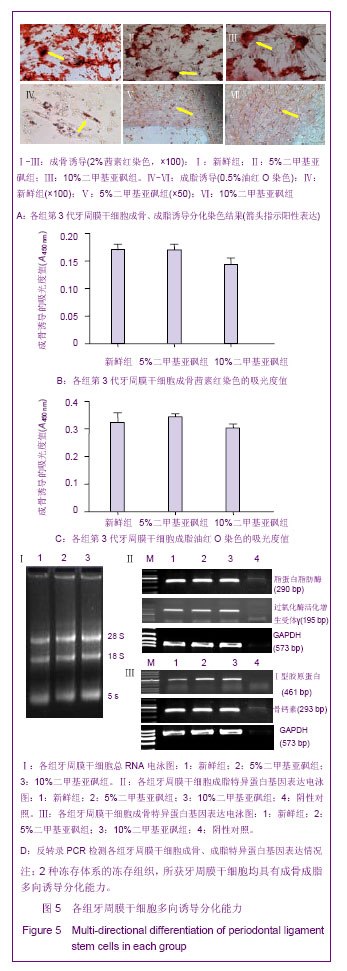Chinese Journal of Tissue Engineering Research ›› 2013, Vol. 17 ›› Issue (32): 5855-5862.doi: 10.3969/j.issn.2095-4344.2013.32.017
Previous Articles Next Articles
Periodontal ligament stem cells expansion in vitro under different cryopreservation systems
Wang Xuan1, Liu Yi-shan1, Ma Yan2, Bi Xiao-juan2, Zheng Shu-tao3, Liu Jia1, Li Bo-qi1, Sun Da-lei1, Zhao Jin4
- 1Department of Pediatric Dentistry & Oral Prevention and Health Care, 4Department of Endodontics, First Affiliated Hospital of Xinjiang Medical University, Urumqi 830011, Xinjiang Uygur Autonomous Region, China; 2Stem Cell Research Laboratory, Clinical Medical Research Institute of Xinjiang Medical University, Urumqi 830011, Xinjiang Uygur Autonomous Region, China; 3Clinical Medical Research Institute, State Key Lab Incubation Base of Xinjiang Major Diseases Research, First Affiliated Hospital of Xinjiang Medical University, Urumqi 830011, Xinjiang Uygur Autonomous Region, China
-
Received:2013-05-27Revised:2013-06-15Online:2013-08-06Published:2013-08-06 -
Contact:Zhao Jin, M.D., Chief physician, Professor, Department of Endodontics, First Affiliated Hospital of Xinjiang Medical University, Urumqi 830011, Xinjiang Uygur Autonomous Region, China merryljin@sina.com -
About author:Wang Xuan★, Master, Attending physician, Department of Pediatric Dentistry & Oral Prevention and Health Care, First Affiliated Hospital of Xinjiang Medical University, Urumqi 830011, Xinjiang Uygur Autonomous Region, China wangjieqiu126@sina.com -
Supported by:the Natural Science Foundation of Xinjiang Uygur Autonomous Region for the Youth, No. 2013211B58*
CLC Number:
Cite this article
Wang Xuan, Liu Yi-shan, Ma Yan, Bi Xiao-juan, Zheng Shu-tao, Liu Jia, Li Bo-qi, Sun Da-lei, Zhao Jin. Periodontal ligament stem cells expansion in vitro under different cryopreservation systems[J]. Chinese Journal of Tissue Engineering Research, 2013, 17(32): 5855-5862.
share this article
| [1] Ohta S, Yamada S, Matuzaka K, et al. The behavior of stem cells and progenitor cells in the periodontal ligament during wound healing as observed using immunohistochemical methods. J Periodontal Res. 2008;43(6):595-603.[2] Yang Z, Jin F, Zhang X, et al. Tissue engineering of cementum/periodontal-ligament complex using a novel three-dimensional pellet cultivation system for human periodontal ligament stem cells. Tissue Eng Part C Methods. 2009;15(4):571-581. [3] Fabricant L, Kiraly L, Wiles C, et al. Cryopreserved deglycerolized blood is safe and achieves superior tissue oxygenation compared with refrigerated red blood cells: a prospective randomized pilot study. J Trauma Acute Care Surg. 2013;74(2):371-377. [4] Seo JH, Youn HS, Goo MJ, et al. Recovery of Helicobacter pylori from gastric tissue cryopreserved for more than 10 years. Helicobacter. 2013;18(2):167-168. [5] Balci D, Can A. The assessment of cryopreservation conditions for human umbilical cord stroma-derived mesenchymal stem cells towards a potential use for stem cell banking. Curr Stem Cell Res Ther. 2013;8(1):60-72.[6] Wang Y, Bai J, Chen J, et al. Comparative studies on different cryopreservation protocols of human amniotic fluid-derived mesenchymal stem cells. Zhongguo Xiu Fu Chong Jian Wai Ke Za Zhi. 2012;26(2):141-145.[7] Fu Y, Pan S, Liu Q, et al. Cryopreservation and resuscitation of neural stem cells from fetal rat. Lin Chung Er Bi Yan Hou Tou Jing Wai Ke Za Zhi. 2010;24(7):311-314.[8] Wanderley LS, Luz HK, Faustino LR, et al. Ultrastructural features of agouti (Dasyprocta aguti) preantral follicles cryopreserved using dimethyl sulfoxide, ethylene glycol and propanediol. Theriogenology. 2012;77(2):260-267. [9] Castro SV, de Carvalho AA, da Silva CM, et al. Freezing solution containing dimethylsulfoxide and fetal calf serum maintains survival and ultrastructure of goat preantral follicles after cryopreservation and in vitro culture of ovarian tissue. Cell Tissue Res. 2011;346(2):283-292.[10] Oz ES, Aydemir E, F??k?n K. DMSO exhibits similar cytotoxicity effects to thalidomide in mouse breast cancer cells. Oncol Lett. 2012;3(4):927-929.[11] Nocca G, D'Antò V, Rivieccio V, et al. Effects of ethanol and dimethyl sulfoxide on solubility and cytotoxicity of the resin monomer triethylene glycol dimethacrylate. J Biomed Mater Res B Appl Biomater. 2012;100(6):1500-1506. [12] Jia Z, Zhu H, Li Y, et al. Potent inhibition of peroxynitrite- induced DNA strand breakage and hydroxyl radical formation by dimethyl sulfoxide at very low concentrations. Exp Biol Med (Maywood). 2010;235(5):614-622. [13] Wang WJ, Zhao YM, Feng XY, et al. Effect of skimmed pasteurized milk and Hank's balanced salt solution on viability and osteogenic differentiation of human periodontal ligament stem cells. Dent Traumatol. 2012. in press.[14] Alencar S, Garnica M, Luiz RR, et al. Cryopreservation of peripheral blood stem cell: the influence of cell concentration on cellular and hematopoietic recovery. Transfusion. 2010; 50(11):2402-2412.[15] Xu X, Cowley S, Flaim CJ, et al. Enhancement of cell recovery for dissociated human embryonic stem cells after cryopreservation. Biotechnol Prog. 2010;26(3):781-788. [16] 别利克孜•卡德尔,刘奕杉,王璇,等.改良酶消化法分离培养人乳牙牙髓干细胞[J].中国组织工程研究,2013,17(10):1793-1800.[17] Ye J, Nishimura F, Orman R, et al. Isolation, purification, and partial characterization of an autocrine periodontal ligament cell chemotactic factor. J Dent Res. 1995;74(6):1303-1309.[18] Seo BM, Miura M, Sonoyama W, et al. Recovery of stem cells from cryopreserved periodontal ligament. J Dent Res. 2005; 84(10):907-912.[19] Shen T, Chang HJ, Jian CX, et al. Isolation and identification of human periodontal ligament stem cells in vitro. Hua Xi Kou Qiang Yi Xue Za Zhi. 2011;29(1):71-74, 78.[20] Du L, Yang P, Zhao N, et al. Culturing and characterization of human periodontal ligament stem cells and investigating their chemotactic responses to bone morphogenetic protein-2. Hua Xi Kou Qiang Yi Xue Za Zhi. 2012;30(1):13-17.[21] Choi S, Murphy WL. A screening approach reveals the influence of mineral coating morphology on human mesenchymal stem cell differentiation. Biotechnol J. 2013; 8(4):496-501. [22] Abusin GA, Abu-Arja RF, Gingrich RD, et al. An algorithm for utilizing peripheral blood CD34 count as a predictor of the need for plerixafor in autologous stem cell mobilization-cost- effectiveness analysis. J Clin Apher. 2013. in press.[23] Mitani N, Yujiri T, Tanaka Y, et al. Hematopoietic progenitor cell count, but not immature platelet fraction value, predicts successful harvest of autologous peripheral blood stem cells. J Clin Apher. 2011;26(3):105-110. [24] Zhang HW, Ding J, Jin JL, et al. Defects in mesenchymal stem cell self-renewal and cell fate determination lead to an osteopenic phenotype in Bmi-1 null mice. J Bone Miner Res. 2010;25(3):640-652.[25] Fariha MM, Chua KH, Tan GC, et al. Human chorion-derived stem cells: changes in stem cell properties during serial passage. Cytotherapy. 2011;13(5):582-593. [26] Hatlapatka T, Moretti P, Lavrentieva A, et al. Optimization of culture conditions for the expansion of umbilical cord-derived mesenchymal stem or stromal cell-like cells using xeno-free culture conditions. Tissue Eng Part C Methods. 2011;17(4): 485-493.[27] Im do J, Noh J, Yi NW, et al. Influences of electric field on living cells in a charged water-in-oil droplet under electrophoretic actuation. Biomicrofluidics. 2011;5(4):44112-4411210. [28] Zhu WZ, Li X, Qi JP, et al. Experimental study of cell migration and functional differentiation of transplanted neural stem cells co-labeled with superparamagnetic iron oxide and BrdU in an ischemic rat model. Biomed Environ Sci. 2008;21(5):420-424.[29] Lehner B, Sandner B, Marschallinger J, et al. The dark side of BrdU in neural stem cell biology: detrimental effects on cell cycle, differentiation and survival. Cell Tissue Res. 2011;345 (3): 313-328.[30] van Meerloo J, Kaspers GJ, Cloos J. Cell sensitivity assays: the MTT assay. Methods Mol Biol. 2011;731:237-245.[31] Buch K, Peters T, Nawroth T, et al. Determination of cell survival after irradiation via clonogenic assay versus multiple MTT Assay--a comparative study. Radiat Oncol. 2012;7:1. [32] Ho WY, Yeap SK, Ho CL, et al. Development of multicellular tumor spheroid (MCTS) culture from breast cancer cell and a high throughput screening method using the MTT assay. PLoS One. 2012;7(9):e44640. [33] Kim E, Jeon IS, Kim JW, et al. An MTT-based method for quantification of periodontal ligament cell viability. Oral Dis. 2007;13(5):495-499.[34] Kémoun P, Gronthos S, Snead ML, et al. The role of cell surface markers and enamel matrix derivatives on human periodontal ligament mesenchymal progenitor responses in vitro. Biomaterials. 2011;32(30):7375-7388. [35] Liu J, Zha HY, Xuan DY, et al. Differentiation characteristics of human periodontal ligament cell population in vitro. Hua Xi Kou Qiang Yi Xue Za Zhi. 2010;28(2):185-189.[36] Clabaut A, Delplace S, Chauveau C, et al. Human osteoblasts derived from mesenchymal stem cells express adipogenic markers upon coculture with bone marrow adipocytes. Differentiation. 2010;80(1):40-45. [37] Park HE, Kim D, Koh HS, et al. Real-time monitoring of neural differentiation of human mesenchymal stem cells by electric cell-substrate impedance sensing. J Biomed Biotechnol. 2011; 2011:485173. [38] Fraser GJ, Bloomquist RF, Streelman JT. Common developmental pathways link tooth shape to regeneration. Dev Biol. 2013;377(2):399-414.[39] Seo BM, Miura M, Gronthos S, et al. Investigation of multipotent postnatal stem cells from human periodontal ligament. Lancet. 2004;364(9429):149-155.[40] Liu L, Ling J, Wei X, et al. Stem cell regulatory gene expression in human adult dental pulp and periodontal ligament cells undergoing odontogenic/osteogenic differentiation. J Endod. 2009;35(10):1368-1376. [41] Mirabet V, Alvarez M, Solves P, et al. Use of liquid nitrogen during storage in a cell and tissue bank: contamination risk and effect on the detectability of potential viral contaminants. Cryobiology. 2012;64(2):121-123. [42] Seo BM, Miura M, Sonoyama W, et al. Recovery of stem cells from cryopreserved periodontal ligament. J Dent Res. 2005; 84(10):907-912.[43] Nishigaki T, Teramura Y, Nasu A, et al. Highly efficient cryopreservation of human induced pluripotent stem cells using a dimethyl sulfoxide-free solution. Int J Dev Biol. 2011;55(3):305-311. [44] Han DL, Liu KQ, Guo SS, et al. Dose-effect relationship of DMSO and Tween 80 influencing the growth and viability of murine bone marrow-derived cells in vitro. Zhongguo Shi Yan Xue Ye Xue Za Zhi. 2008;16(2):377-380.[45] Lee SY, Huang GW, Shiung JN, et al. Magnetic cryopreservation for dental pulp stem cells. Cells Tissues Organs. 2012;196(1):23-33. [46] Collart Dutilleul PY, Thonat C, Jacquemart P, et al. Dental pulp stem cells: characteristics, cryopreservation and therapeutic potentialities. Orthod Fr. 2012;83(3):209-216. [47] Balci D, Can A. The assessment of cryopreservation conditions for human umbilical cord stroma-derived mesenchymal stem cells towards a potential use for stem cell banking. Curr Stem Cell Res Ther. 2013;8(1):60-72. |
| [1] | Pu Rui, Chen Ziyang, Yuan Lingyan. Characteristics and effects of exosomes from different cell sources in cardioprotection [J]. Chinese Journal of Tissue Engineering Research, 2021, 25(在线): 1-. |
| [2] | Zhang Xiumei, Zhai Yunkai, Zhao Jie, Zhao Meng. Research hotspots of organoid models in recent 10 years: a search in domestic and foreign databases [J]. Chinese Journal of Tissue Engineering Research, 2021, 25(8): 1249-1255. |
| [3] | Wang Zhengdong, Huang Na, Chen Jingxian, Zheng Zuobing, Hu Xinyu, Li Mei, Su Xiao, Su Xuesen, Yan Nan. Inhibitory effects of sodium butyrate on microglial activation and expression of inflammatory factors induced by fluorosis [J]. Chinese Journal of Tissue Engineering Research, 2021, 25(7): 1075-1080. |
| [4] | Wang Xianyao, Guan Yalin, Liu Zhongshan. Strategies for improving the therapeutic efficacy of mesenchymal stem cells in the treatment of nonhealing wounds [J]. Chinese Journal of Tissue Engineering Research, 2021, 25(7): 1081-1087. |
| [5] | Liao Chengcheng, An Jiaxing, Tan Zhangxue, Wang Qian, Liu Jianguo. Therapeutic target and application prospects of oral squamous cell carcinoma stem cells [J]. Chinese Journal of Tissue Engineering Research, 2021, 25(7): 1096-1103. |
| [6] | Xie Wenjia, Xia Tianjiao, Zhou Qingyun, Liu Yujia, Gu Xiaoping. Role of microglia-mediated neuronal injury in neurodegenerative diseases [J]. Chinese Journal of Tissue Engineering Research, 2021, 25(7): 1109-1115. |
| [7] | Li Shanshan, Guo Xiaoxiao, You Ran, Yang Xiufen, Zhao Lu, Chen Xi, Wang Yanling. Photoreceptor cell replacement therapy for retinal degeneration diseases [J]. Chinese Journal of Tissue Engineering Research, 2021, 25(7): 1116-1121. |
| [8] | Jiao Hui, Zhang Yining, Song Yuqing, Lin Yu, Wang Xiuli. Advances in research and application of breast cancer organoids [J]. Chinese Journal of Tissue Engineering Research, 2021, 25(7): 1122-1128. |
| [9] | Wang Shiqi, Zhang Jinsheng. Effects of Chinese medicine on proliferation, differentiation and aging of bone marrow mesenchymal stem cells regulating ischemia-hypoxia microenvironment [J]. Chinese Journal of Tissue Engineering Research, 2021, 25(7): 1129-1134. |
| [10] | Zeng Yanhua, Hao Yanlei. In vitro culture and purification of Schwann cells: a systematic review [J]. Chinese Journal of Tissue Engineering Research, 2021, 25(7): 1135-1141. |
| [11] | Kong Desheng, He Jingjing, Feng Baofeng, Guo Ruiyun, Asiamah Ernest Amponsah, Lü Fei, Zhang Shuhan, Zhang Xiaolin, Ma Jun, Cui Huixian. Efficacy of mesenchymal stem cells in the spinal cord injury of large animal models: a meta-analysis [J]. Chinese Journal of Tissue Engineering Research, 2021, 25(7): 1142-1148. |
| [12] | Hou Jingying, Yu Menglei, Guo Tianzhu, Long Huibao, Wu Hao. Hypoxia preconditioning promotes bone marrow mesenchymal stem cells survival and vascularization through the activation of HIF-1α/MALAT1/VEGFA pathway [J]. Chinese Journal of Tissue Engineering Research, 2021, 25(7): 985-990. |
| [13] | Shi Yangyang, Qin Yingfei, Wu Fuling, He Xiao, Zhang Xuejing. Pretreatment of placental mesenchymal stem cells to prevent bronchiolitis in mice [J]. Chinese Journal of Tissue Engineering Research, 2021, 25(7): 991-995. |
| [14] | Liang Xueqi, Guo Lijiao, Chen Hejie, Wu Jie, Sun Yaqi, Xing Zhikun, Zou Hailiang, Chen Xueling, Wu Xiangwei. Alveolar echinococcosis protoscolices inhibits the differentiation of bone marrow mesenchymal stem cells into fibroblasts [J]. Chinese Journal of Tissue Engineering Research, 2021, 25(7): 996-1001. |
| [15] | Fan Quanbao, Luo Huina, Wang Bingyun, Chen Shengfeng, Cui Lianxu, Jiang Wenkang, Zhao Mingming, Wang Jingjing, Luo Dongzhang, Chen Zhisheng, Bai Yinshan, Liu Canying, Zhang Hui. Biological characteristics of canine adipose-derived mesenchymal stem cells cultured in hypoxia [J]. Chinese Journal of Tissue Engineering Research, 2021, 25(7): 1002-1007. |
| Viewed | ||||||
|
Full text |
|
|||||
|
Abstract |
|
|||||
